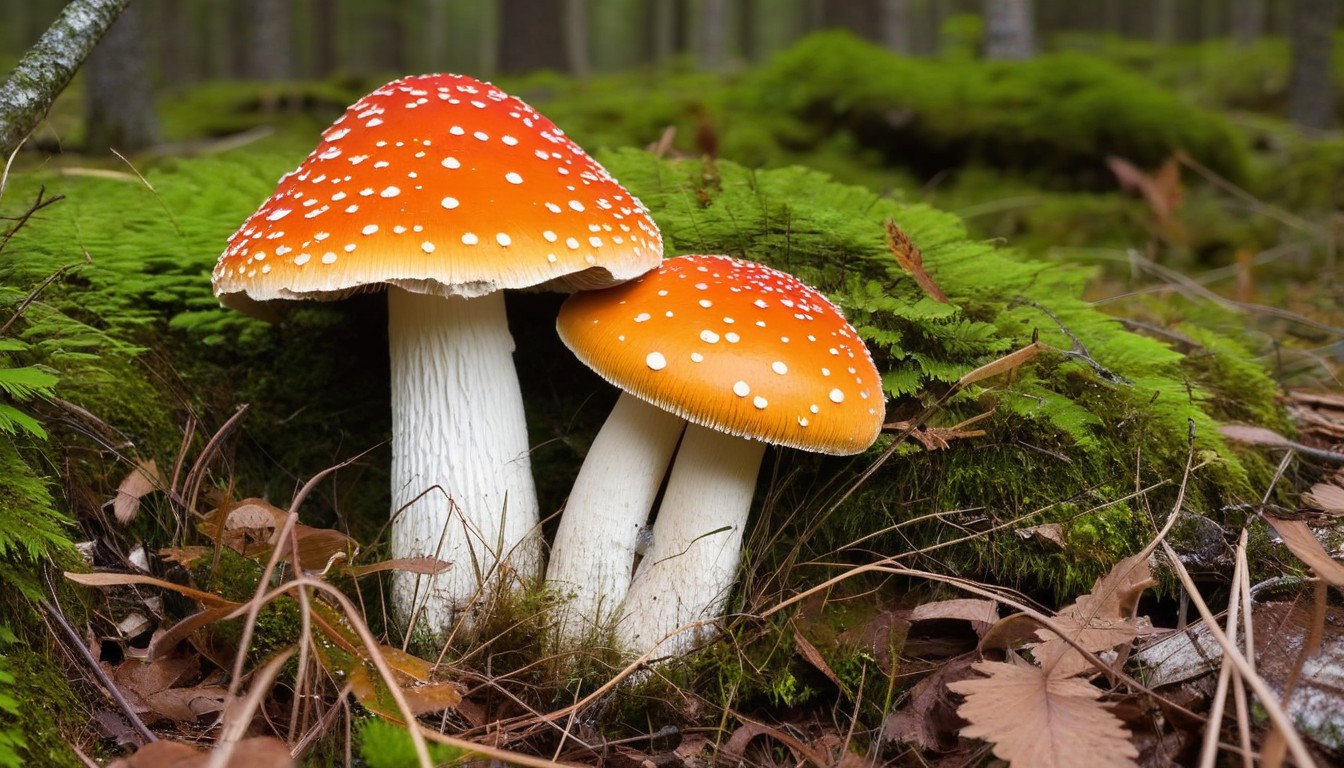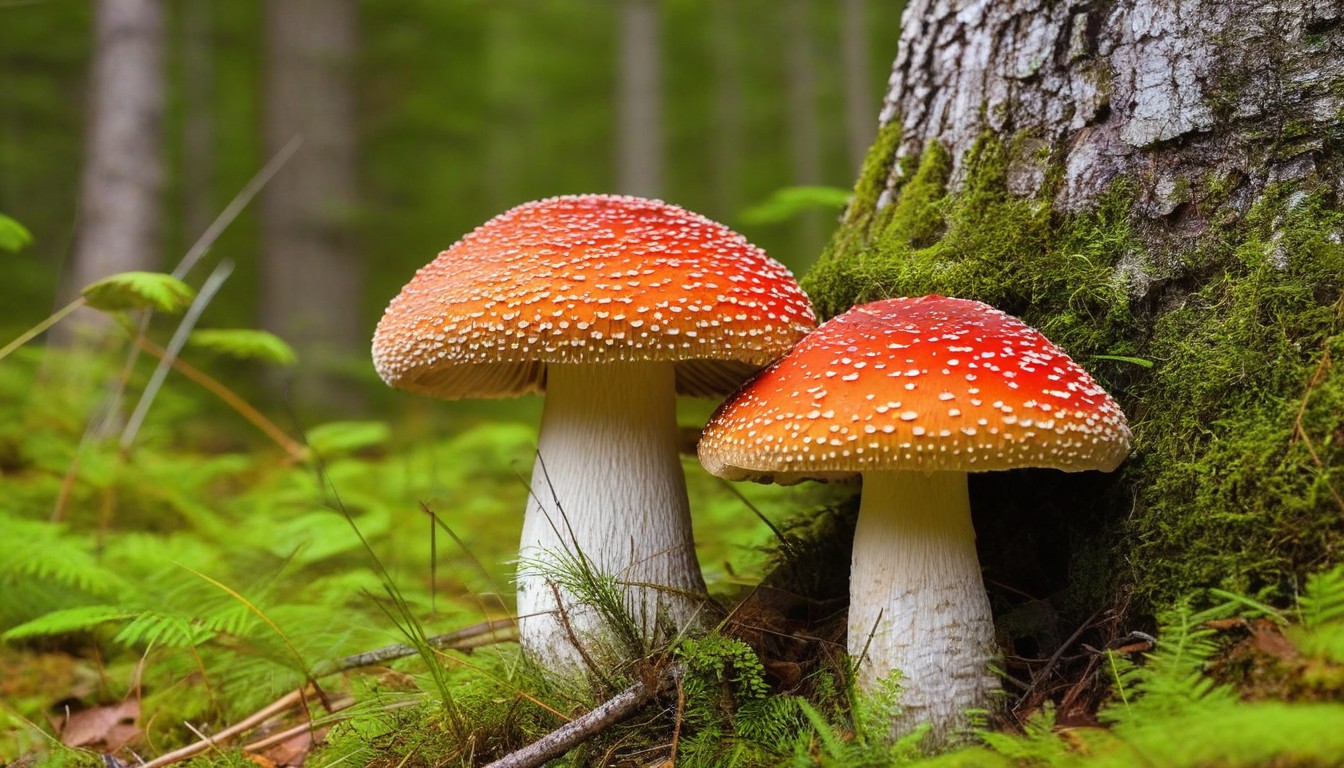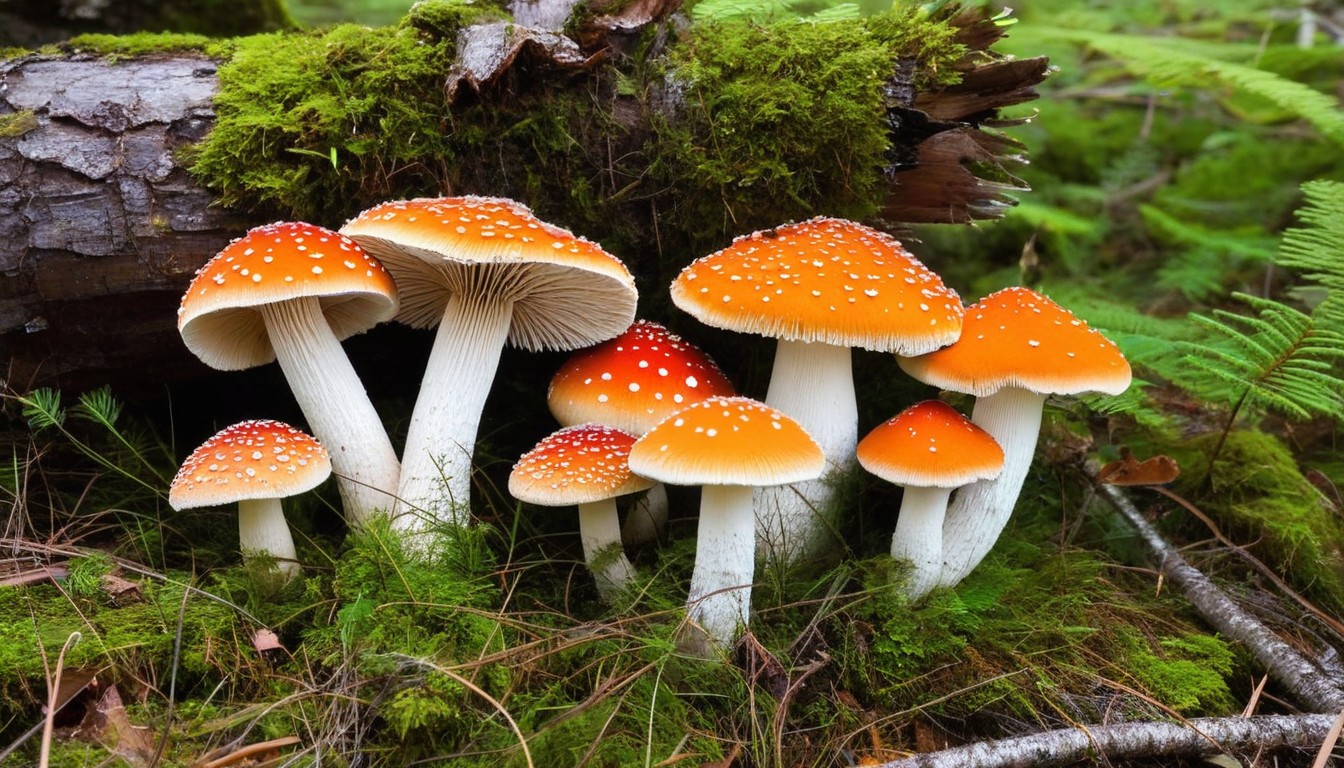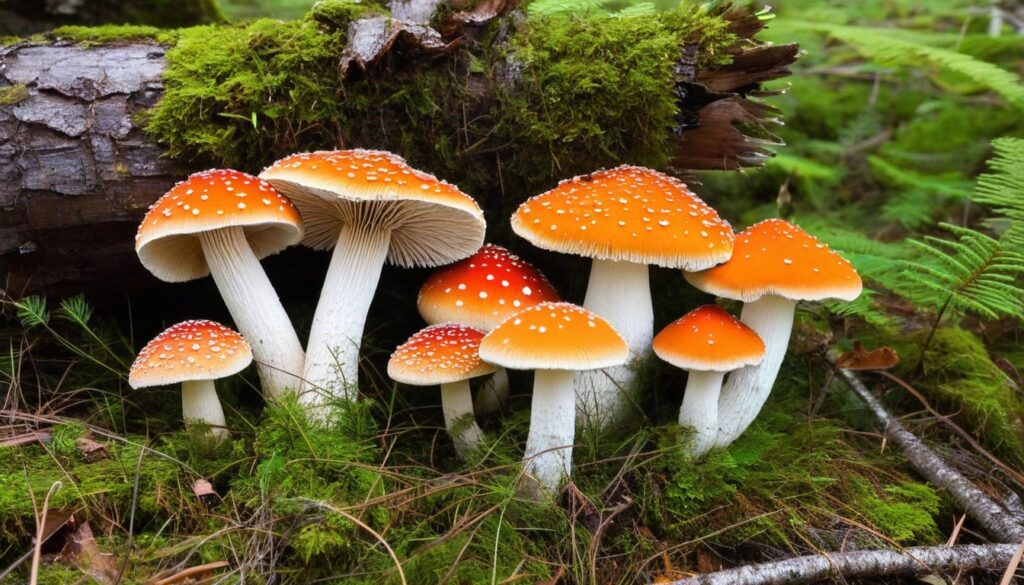Are you interested in exploring the natural wonders of Maine? Have you ever considered foraging for edible mushrooms? Look no further! In this comprehensive guide, we will introduce you to the diverse world of Maine’s edible mushrooms and provide you with the knowledge to safely forage for these delicious fungi.
From the iconic Morel to the savory Chanterelle, Maine is home to a variety of edible mushrooms waiting to be discovered. Learn how to identify and locate these prized fungi and explore the culinary possibilities they offer.
Key Takeaways
- Discover the diverse world of Maine’s edible mushrooms
- Learn essential safety measures for mushroom foraging
- Explore common edible mushroom species found in Maine
- Discover the culinary possibilities of Maine’s edible mushrooms
- Gain insights into ethical foraging practices
Why Forage for Edible Mushrooms in Maine?
Foraging for edible mushrooms in Maine is an exciting adventure that offers a multitude of benefits. Not only is it a fun and engaging outdoor activity, but it provides an opportunity to connect with nature and discover new flavors.
Maine is home to a diverse range of edible mushroom species, each with its distinct taste and texture. From the earthy flavor of the Black Trumpet to the delicate sweetness of the Lobster Mushroom, there is a mushroom for every taste preference.
Foraging for edible mushrooms also allows you to gain a deeper appreciation for the environment and its intricate ecosystem. By learning about the different types of mushrooms and where they grow, you will become more aware of the natural world around you and how to preserve it.
Benefits of Foraging for Edible Mushrooms in Maine
- Enjoy the great outdoors and connect with nature
- Discover unique flavors and culinary possibilities
- Gain knowledge about the environment and its ecosystem
- Engage in a sustainable and ethical food source
Foraging for edible mushrooms is not only a fun and rewarding experience but also a great way to incorporate fresh, sustainable ingredients into your cooking. By foraging for your own food, you cultivate a deeper understanding and appreciation for the environment and the food that sustains us.
Safety Measures for Mushroom Foraging
Foraging for mushrooms is a fun and rewarding activity, but it can also be dangerous if proper safety measures are not followed. Before heading out to the woods to hunt for mushrooms, take the time to educate yourself on the necessary safety precautions.
Always Identify Mushrooms Correctly
Correctly identifying mushrooms is essential to avoid consuming poisonous varieties. Many edible mushrooms have toxic counterparts, so it is crucial to learn how to differentiate between the two. Consider investing in a field guidebook or attending a mushroom identification workshop.
Protect Yourself
It’s important to take appropriate measures to protect yourself while foraging, especially when handling unknown mushrooms. Wear gloves and bring a knife to cut mushrooms rather than pulling them from the ground, which can disturb the root system, making it difficult to distinguish between species.
Avoid Environmental Hazards
When foraging, be aware of your surroundings and avoid potential hazards. Be cautious of wildlife, insects, and other potentially dangerous plants. Additionally, avoid foraging in areas near roads, industrial sites, and polluted water sources, which can contaminate mushrooms.
Know Your Limits
While foraging can be a fun and exciting experience, it’s important to know your limits. Avoid pushing yourself too hard, especially if you’re not an experienced hiker. Take frequent breaks, stay hydrated, and monitor your energy levels to avoid exhaustion.
“Foraging for mushrooms can be a very rewarding experience, but it’s important to follow safety measures to avoid any potential dangers.”
Common Edible Mushroom Species in Maine
Maine is home to a diverse range of edible mushrooms that vary in size, color, and flavor. Here are some of the most common and popular edible mushroom species found in Maine:
|
Mushroom Species |
Appearance |
Flavor |
Harvest Season |
|---|---|---|---|
|
Morel |
Distinct honeycomb-like cap, ranging in color from light beige to dark brown |
Nutty, earthy |
Spring (April-May) |
|
Chanterelle |
Trumpet-shaped cap, ranging in color from yellow to orange |
Fruity, apricot-like |
Summer to Fall (July-November) |
|
Hen of the Woods (Maitake) |
Frilly, ruffled caps in shades of brown and gray |
Nutty, earthy |
Fall (September-November) |
|
Bolete |
Smooth or slightly rough-textured cap, ranging in color from brown to red |
Rich, meaty |
Summer to Fall (July-October) |
It’s important to note that there are many other edible mushroom species in Maine, and it’s crucial to develop a thorough understanding of each mushroom’s unique characteristics before foraging. Always consult with a local expert or guide, or reference a reliable field guide before harvesting any wild mushrooms.
Preparing and Cooking Maine Edible Mushrooms
Once you’ve successfully foraged for Maine’s delicious edible mushrooms, the next step is preparing and cooking them to perfection. Different species require unique techniques and handling, so let’s explore some tips on how to bring out the best in each mushroom.
Cleaning Your Mushrooms

Before you start cooking, it’s essential to clean your mushrooms thoroughly. Never wash them under a faucet, as they will absorb too much water and become soggy. Instead, use a soft brush or a damp cloth to remove dirt and debris gently. Once clean, trim the stems and cut off any bruised or damaged areas.
Let’s Get Cooking!
Each edible mushroom species has its unique flavor profile and pairs well with different ingredients. Here are some popular cooking methods to enhance your mushroom’s taste:
- Sautéing: Add some butter or oil to a heated pan and cook your mushrooms over medium-high heat until they are tender and lightly browned. Add garlic or herbs to elevate the flavors.
- Grilling: Brush your mushrooms with oil or butter and grill them over high heat. You can also skewer them with other vegetables or meat for a flavorful kebab.
- Baking: Stuff your mushrooms with cheese, herbs, or breadcrumbs and bake them in the oven for a delicious appetizer or side dish.
Pairing With Other Ingredients
While Maine’s edible mushrooms have a distinct flavor, you can complement it by pairing them with other ingredients. Here are some suggestions:
|
Mushroom Type |
Complementary Ingredients |
|---|---|
|
Morel |
Asparagus, shallots, cream, white wine |
|
Chanterelle |
Garlic, thyme, parsley, lemon, chicken, risotto |
|
Boletus |
Beef, potatoes, onions, rosemary, red wine |
Wrap Up
Preparing and cooking Maine’s edible mushrooms is a delightful experience that allows you to showcase their unique flavors. Remember to clean them thoroughly and use appropriate cooking methods to elevate their taste. Don’t be afraid to experiment with pairings and discover new culinary possibilities!
Ethical Foraging Practices

Foraging for Maine’s edible mushrooms is not only an exciting activity but also an opportunity to connect with nature and promote a sustainable relationship with the environment. Therefore, it is essential to follow ethical foraging practices to ensure that mushroom habitats remain healthy and productive for years to come.
Here are some tips for ethical mushroom foraging in Maine:
- Always forage in designated areas and follow posted guidelines.
- Do not pick mushrooms that are too young or too small, as this can prevent future growth and reproduction.
- Only harvest what you need and leave enough mushrooms behind for others, including animals and insects that rely on them for food and habitat.
- Avoid damaging the surrounding area when searching for mushrooms and be mindful of other plant life and wildlife in the area.
- Do not pick mushrooms in polluted areas or near roadsides where they may have absorbed harmful chemicals.
By following these ethical foraging practices, you can promote the growth and diversity of Maine’s edible mushroom population while also preserving the natural environment.
“Foraging should be done as a respectful practice, and with consideration for the environment we share with other creatures.”
Matthew Rooney, a biologist at the University of Maine.
Mushroom Foraging Seasons in Maine
Each season brings its own unique selection of mushrooms to forage in Maine. Below we’ve listed the most common edible mushroom species and when you can expect to find them:
|
Mushroom Species |
Season |
|---|---|
|
Morel |
Spring (April – May) |
|
Chanterelle |
Summer (July – September) |
|
Hen of the Woods |
Fall (September – November) |
|
Black Trumpet |
Fall (October – November) |
|
Porcini |
Fall (August – October) |
It’s important to note that environmental conditions can impact the growth and availability of these mushrooms. For example, a wet spring season may lead to morel mushrooms appearing earlier than usual. It’s always a good idea to check with local experts or resources to stay up-to-date on current conditions and regulations regarding mushroom foraging in Maine.
Other Edible Natural Delights in Maine

While mushrooms are undoubtedly a highlight of Maine’s edible offerings, they are not the only delicacies waiting to be discovered in the state’s outdoors. From sweet berries to nutty greens, Maine has a diverse range of wild edibles that can add a unique touch to any meal.
Berries
As the summer sun brings warmth to the forests, a variety of berries ripen and become available for foragers. Some popular options include:
|
Berry |
Season |
|---|---|
|
Blueberries |
July to August |
|
Raspberries |
June to July |
|
Blackberries |
July to August |
These flavorful and nutritious berries can be eaten fresh or used to make jams, pies, and other desserts.
Nuts
Maine’s forests are also home to a variety of nut trees, including:
- Walnuts
- Hazelnuts
- Chestnuts
These nuts can be roasted and eaten as a snack or used in savory dishes for added flavor and texture.
Greens
Finally, Maine’s forests and meadows are full of wild greens that can be foraged and added to salads or cooked dishes. Some popular options include:
- Dandelion leaves
- Fiddlehead ferns
- Wild leeks
Be sure to do your research before foraging for greens, as some varieties can be harmful if not prepared correctly.
With so many delicious and nutritious options waiting to be discovered, foraging for natural delights in Maine is an exciting and rewarding adventure.
Conclusion
Foraging for edible mushrooms in Maine is a fulfilling and exciting experience. With this guide, you now have a better understanding of the types of edible mushrooms found in the region, the safety precautions to follow, and the best practices for sustainable foraging.
Remember to always respect the environment and practice ethical foraging. Leave no trace and preserve the habitat for future generations to enjoy.
Get started on your foraging journey today!
Head out into Maine’s great outdoors and explore the vast array of edible natural delights that can be found. With patience, persistence, and a little bit of luck, you’ll be able to uncover some amazing mushrooms and other wild edibles that will tantalize your taste buds.
So, grab your basket, put on your hiking boots, and start your foraging adventure today! Happy hunting!
FAQ
How can I safely identify edible mushrooms?
Identifying edible mushrooms can be challenging, but there are several key characteristics to look for. Pay attention to the color, shape, and texture of the mushroom, as well as any distinctive features such as gills or pores. It is always best to consult a reliable field guide or seek guidance from experienced foragers before consuming any wild mushroom.
Are there any poisonous mushrooms in Maine?
Yes, Maine is home to several poisonous mushroom species. It is crucial to correctly identify mushrooms before consuming them, as some poisonous varieties can be lethal. Always err on the side of caution and avoid consuming any mushroom unless you are confident in its identification.
Can I sell the mushrooms I forage in Maine?
Selling wild mushrooms in Maine requires a license. It is important to familiarize yourself with the state’s regulations regarding foraged food sales and obtain the necessary permits if you plan to sell your mushrooms commercially.
Can I forage for mushrooms in Maine’s national parks?
Each national park in Maine has its own regulations regarding foraging. It is best to check with park authorities before engaging in any foraging activities. Some parks may strictly prohibit foraging, while others may allow it under certain conditions.
Are there any poisonous plants I should be aware of while foraging for mushrooms?
Yes, there are various poisonous plants in Maine’s wilderness that you should be aware of while foraging. Familiarize yourself with common toxic plants, such as poison ivy and poison sumac, to avoid any unwanted encounters.
Can I forage for mushrooms in Maine during winter?
While the peak foraging season for mushrooms in Maine is typically spring through fall, some cold-hardy species can be found during winter. It is essential to have a thorough understanding of winter mushroom species and their unique habitats before attempting to forage during this time of year.

